Most keto-related side effects are straightforward and easy to remedy. There is one issue, however, that has been causing a great deal of concern and confusion for many keto dieters — and it is known as the “keto rash.”
Despite its unsightly appearance and irritating itchiness, this rash is not dangerous at all. In fact, it is both preventable and treatable.
But before we learn how to rid ourselves of the keto rash, let’s take a closer look at what it actually is.
Keto Rash: Why Is Keto Making You Itchy?
Keto rash is a rare inflammatory skin disease of unknown origin, and many keto diet experts believe that the scientific name for it is prurigo pigmentosa. Whether keto rash is the same exact thing as prurigo pigmentosa is not known for sure, but the current literature points to them being the same exact condition.
The cause of the rash is not yet known, and it’s just beginning to be understood and researched in the West. Here’s what we know so far:
- One research review found that 2.6x more females get the rash than men.
- The rash typically affects female teenagers and young adults the most.
- Across several studies, three instances emerged that were most commonly associated with the development of prurigo pigmentosa: lifestyles/diets that promote ketone production, excess emotional stress, and exposure to skin irritants.
- The relationship between ketosis and the development of prurigo pigmentosa in the minority of the study subjects is the main reason for the belief that keto rash is prurigo pigmentosa.
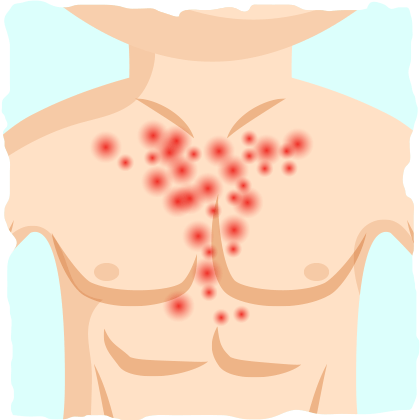
In general, it is safe to say that all keto rashes are also prurigo pigmentosa, but not all instances of prurigo pigmentosa are associated with ketosis. This is very helpful information because it gives us a better idea of what the symptoms of keto rash are, what it looks like, and how we can treat it.
What Are the Symptoms of Keto Rash?
Keto rash usually manifests as itchy, raised skin lesions that can be red, brown, or light pink in color depending on the stage the rash is in. Although it’s unsightly and uncomfortable, it is not life-threatening at all.
It looks similar to eczema and dermatitis (keep this in mind for later when you learn about the potential causes of keto rash), and it typically shows up on your neck, back, chest, shoulders, torso, and armpit areas. It can affect your face and extremities as well, but this is not as common.
Keto rash usually forms a symmetrical pattern on each side of the body in a net-like distribution. Like most rashes, the keto rash will worsen if you expose the rash to heat, sweat, friction, and other potential skin irritants.
What Does Keto Rash Look Like?
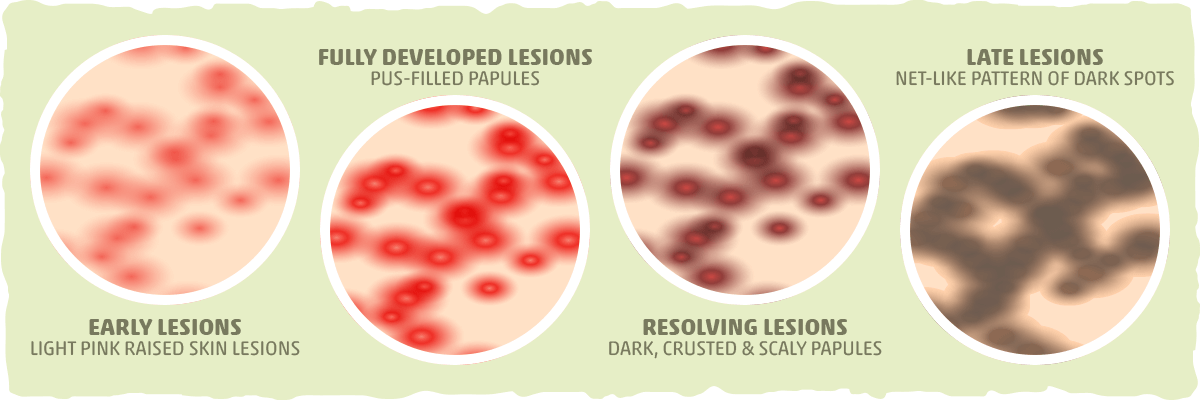
According to the research, people with prurigo pigmentosa (or keto rash) usually go through 4 main stages:
- Early lesions. During this stage, The skin shows light pink raised skin lesions that look like scratch marks. This stage is often overlooked because it just looks like a minor rash or scratch.
- Fully developed lesions. This is the full blown rash people get worried about because it is much more aggressive. During this stage, the skin is infested with pronounced red skin lesions called papules, and sometimes the papules will include liquid-filled cysts or, more rarely, pus-filled cysts.
- Resolving lesions. When the rash is receding, crusted and scaly papules will take the place of the red lesions. The papules will also start to get darker.
- Late lesions. The skin is left with a net-like pattern of dark spots larger than freckles, called “reticulated hyper-pigmentation”. When this happens, the rash is almost fully healed. The pigmentation might remain long after the rash is gone, but the skin will eventually return back to normal.
Source: Dermatopathology: Practical & Conceptual
Source: Journal of the European Academy of Dermatology and Venereology
How Long Will Your Keto Rash Last?
Unfortunately, there is no set time frame for how long it will take your keto rash to go away. For some people, the rash will last for a couple of weeks to months, while others will struggle with it for several months to years.
In general, how long your rash sticks around depends on whether or not you addressed the cause of the rash. If you haven’t dealt with the cause, then it is very likely that the rash will stick around.
To put it in another way:
The best-case scenario for those of you who have keto rash is that it goes away after one to two weeks.
The worst-case scenario is that you’re one of the few people who get it every time you follow keto.
You will either experience one of the two extremes or somewhere in between if you get the keto rash.
It is also important to keep in mind that, regardless of where you fall on the spectrum, the rash will rarely go away unless you address its cause(s) and trigger(s).
What Causes Keto Rash?
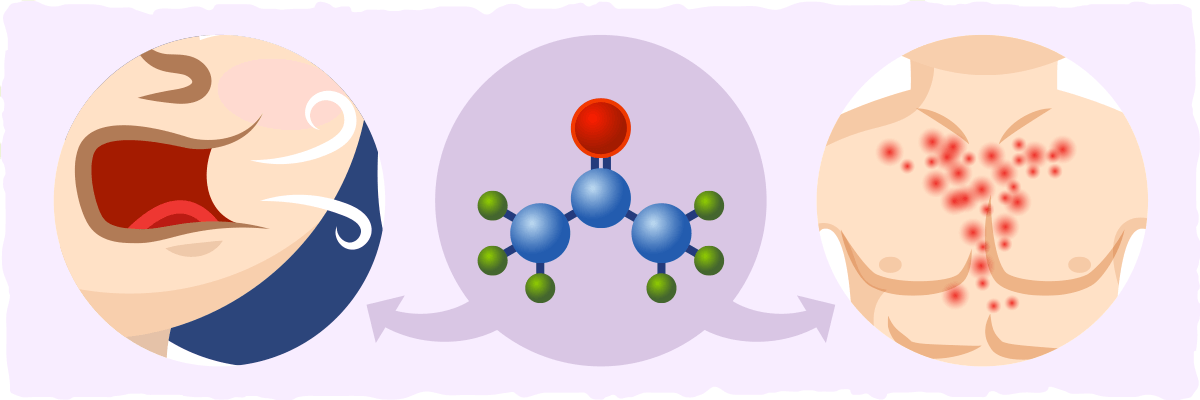
Although many studies have found a link between prurigo pigmentosa and ketosis, the exact cause of the rash is unknown.
However, there is a promising hypothesis behind the cause of keto rash — and it has to do with one little ketone body called acetone. Let me explain what I mean with some common findings from the keto forums and research literature:
- Most of the subjects in the research studies on prurigo pigmentosa had lifestyles, diet strategies, or conditions that promoted ketone production.
- For those who follow keto and get the rash, the itching usually starts soon after they get into ketosis and stops within a day or so if they eat more carbs and exit ketosis.
- Insulin was found to speed up the healing process of prurigo pigmentosa in one study.
- The rash often gets worse in warmer weather and after exercise due to increased sweating.
- The usual distribution of the rash is typically in the areas where we tend to sweat the most.
- When first entering ketosis, we produce more acetone than usual. The acetone is useless to the body, so it is excreted out with the breath and through the sweat.
- When acetone is released through the sweat in high concentrations, it can irritate the skin and cause dermatitis-like symptoms.
To put our findings more succinctly: As a result of producing more ketones for fuel, we create more acetone. This acetone may then be excreted with our sweat, which exposes our skin to excess acetone and causes an inflammatory reaction, itchiness, and lesions on the skin that lead to keto rash.
This potential cause gains further credence when we consider the fact that topical acetone exposure can cause irritation and dermatitis (skin inflammation). Keep this in mind as we explore the triggers of keto rash.
The Lifestyle and Dietary Factors that May Trigger Keto Rash
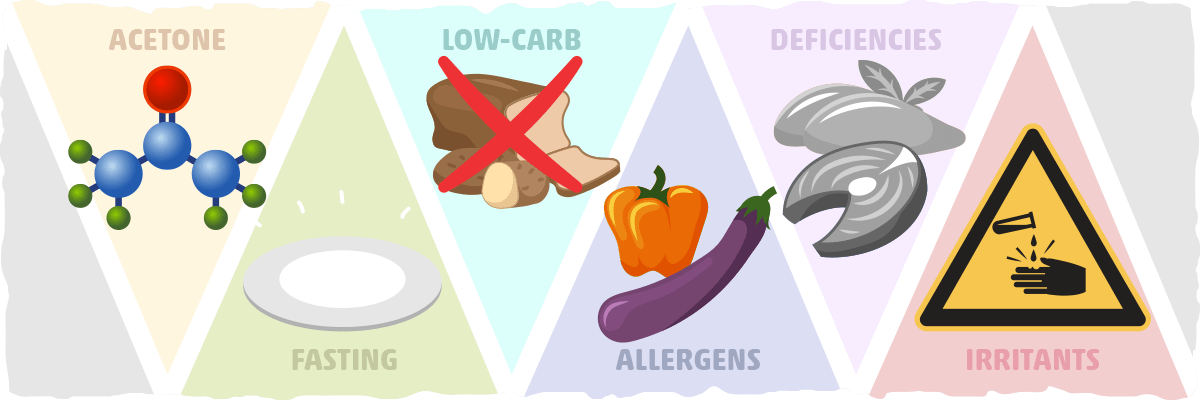
Let’s break our theory and research down to a more practical level to find out what you may be doing that is triggering keto rash:
- Ketosis. One study found that perivascular inflammation (inflammation around your blood vessels) can occur during ketosis and trigger the rash. I suspect that acetone is the ketone culprit in this case.
- Fasting. In one study, 50% of patients showed a relationship between fasting and keto rash. When blood sugar levels dip significantly lower during a fast, your body undergoes extra stress and switches to ketosis. These two factors may trigger the rash.
- Low-Carb Dieting. A low-carb diet, especially one that causes rapid weight-loss and ketone production like the keto diet, has also been associated to the keto rash.
- Allergens. An allergic reaction can be triggered in response to various keto-friendly foods.
- Nutrient Deficiency. A nutrient deficiency, from excluding certain foods, can lead to a rash. For example, vitamin A, niacin, and omega-3 deficiency can all provoke rash-like symptoms.
- External Irritants. Research has found that chlorinated pool water, acetone, and other potential skin irritants are associated with prurigo pigmentosa.
There are many other proposed triggers and causes of keto rash, but the six listed above are the ones that have some scientific evidence backing them.
How To Treat and Cure Keto Rash
Although the cure for keto rash is debatable because the root cause is not clearly defined, there are several research-backed methods you can try to alleviate your symptoms:
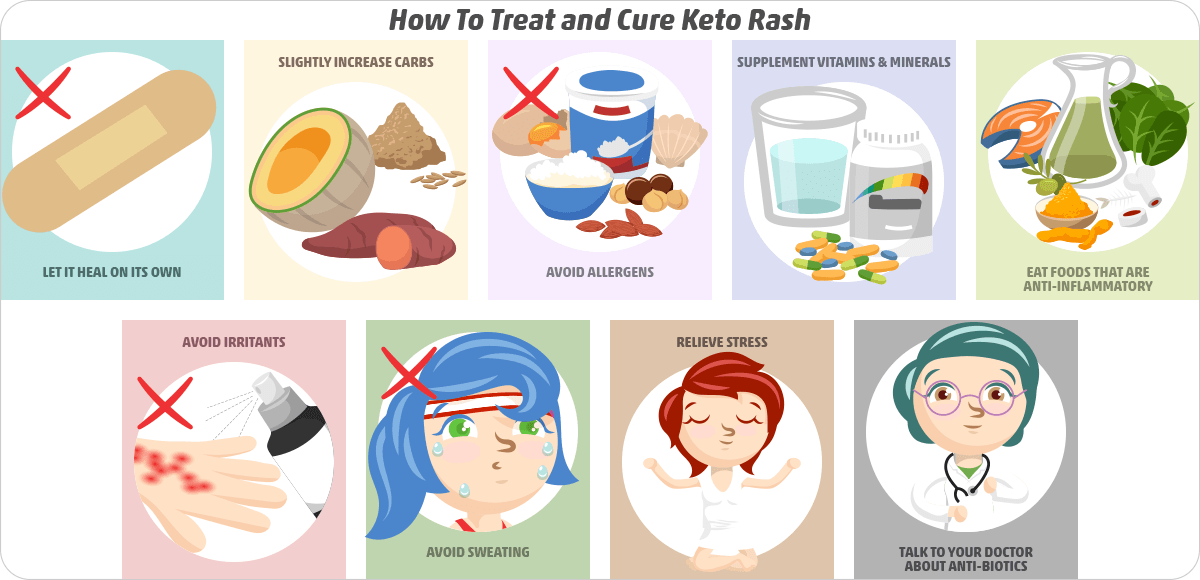
1. Let It Heal on Its Own
The keto rash may go away on its own after a few weeks. In fact, many studies have found that the rash can spontaneously heal within weeks without treatment in some people.
If you’re new to the keto diet, you may just have to wait until your body adjusts to burning ketones for fuel. However, if the rash doesn’t start going away on its own after a month, it’s time to try other options.
2. Increase Your Carb Intake
Unfortunately, for some keto dieters — it doesn’t matter how good they get at producing and using ketones — the rash will still stick around indefinitely. If this sounds like you, then you may need to increase your insulin levels to help the rash heal (as one study suggests).
To test if ketone production might be the cause of your keto rash, you can:
- Try increasing carb intake just enough to get out of ketosis for a few days and see if the rash starts healing.
- If it does start healing, lower carb consumption and enter ketosis again.
- If the rash reappears, then you are probably sensitive to ketones and may need to follow a low carb diet that doesn’t provoke consistent ketone production.
50-100 grams of carbs per day is usually all you need to keep your body from going into ketosis. Over time, you will be able to find your “sweet spot” with carb intake that helps you improve your overall health while reducing the recurrence of the rash.
If you combine this approach with intermittent fasting, you can get many of the benefits of ketosis and fasting without triggering the rash as well.
3. Try Eliminating Allergens from Your Diet
Many diet changes will increase the risk of provoking food allergies. Simply by introducing new foods to our diet or eating large amounts of certain foods, we can trigger a reaction that is responsible for your keto rash.
The most common keto-friendly foods that may trigger allergies are:
- Dairy (e.g., cottage cheese, full-fat yogurt, and hard cheese). For more on dairy allergies and intolerance, check out our dairy-free keto guide.
- Eggs
- Fish (eg. tuna, salmon)
- Shellfish (eg. oysters, clams, crab)
- Tree nuts (eg. macadamia, almonds)
- Peanuts
To find out if you’re allergic to any of these food groups, try an elimination diet:
- Remove one of these food groups from your diet every 3-4 weeks.
- Check if your rash has started to diminish or disappear after this time.
- If it did, then you found a food that is triggering your rash.
- If not, then introduce the food back into your diet and eliminate a new food from the list every 3-4 weeks.
- You may have multiple food triggers, so make sure you try eliminating and reintroducing each one to see how your body reacts.
Important Note: I only recommend doing an elimination-type diet after you’ve tried the simpler strategies on this list first (except for antibiotics).
4. Supplement with Vitamins, Minerals, and Other Nutrients
To rule out any deficiency related causes, make sure to supplement your diet with vitamins and minerals that you may not be getting enough of. For example, you may need to supplement with these nutrients while you are on keto:
- Minerals: sodium, potassium, and magnesium. These minerals are typically excreted in higher quantities while you are transitioning to a ketogenic diet. Make sure you are getting enough of each one because they are vital for multiple metabolic functions.
- Vitamins: vitamin D, vitamin A, and niacin are a couple of vitamins that are essential for skin health and preventing skin inflammation.
- Omega-3s: Omega-3s play a key role in reducing inflammation (which you can read about here) and improving skin health.
- Water: Make sure you are drinking enough water. Most people lose a lot of fluid when they first start keto, which can increase the concentration of acetone in the sweat and provoke keto rash. Drinking more water may help dilute the acetone so that it doesn’t accumulate on your skin when your sweat.
For specific supplement recommendations, click here. If you want more precise water and mineral intake suggestions, read through our guide to the keto flu.
5. Eat More Anti-Inflammatory Foods
Without an inflammatory response, keto rash would not occur. The itchiness and lesions that characterize this irritating rash are simply a result of our immune system being activated by what is happening in and around the skin cells.
To help tame your inflammatory response and reduce the severity of your rash, consider adding these foods to your keto diet:
- This amino acid has a plethora of protective effects that make them a promising treatment strategy for inflammatory diseases like keto rash. To get more glycine in your diet, I recommend eating more animal skin, collagen, bone broth, and/or supplementing with glycine directly.
- Wild Fatty Fish. One of the best ways to get more anti-inflammatory omega-3s is by having sardines, salmon, and other fatty fish.
- You’ve probably already heard of how turmeric is a potent anti-inflammatory, so I’ll spare you the sales pitch. The best way to get the anti-inflammatory benefits of turmeric is by taking a meriva curcumin supplement or a curcumin + bioperine supplement.
- Virgin Olive Oil. Olive oil contains high levels of oleocanthal — a phenolic compound that possesses similar anti-inflammatory properties to ibuprofen. This makes virgin olive oil a great addition to the diet to help reduce acute and chronic inflammation.
- Low Carb Vegetables. Leafy greens, cruciferous vegetables, and other keto-friendly veggies contain hundreds of different phytochemicals, vitamins, and minerals that can help fight off inflammation. Check out our low carb veggie guide for more ideas on what you can eat.
- Low Carb Fruits. Similar to low carb vegetables, low carb fruits pack a powerful anti-inflammatory punch. To get the most benefits from fruit with the least amount of net carbs, I recommend sticking with the berries that you’ll find in our low carb fruit article.
6. Avoid Skin Irritants
A couple of studies on prurigo pigmentosa found that skin irritants, like chlorinated pool water, may trigger the rash. The chemicals in your detergent or the clothes you are wearing may be causing your rash to flare up as well.
For these reasons, we recommend avoiding:
- Any chemicals or products that irritate your skin.
- Rash scratching.
- Wearing tight clothes, especially around the area where you have the rash.
- Using exfoliants on your skin.
- Scrubbing too hard with your bath towel after a shower.
- Using bandages.
- Sleeping over the area that is affected, if possible.
7. Avoid Sweating
Since the acetone in sweat is a major rash trigger, it is best to keep yourself from sweating or at least avoid prolonged exposure to sweat.
Try taking a few days off from the gym or reducing your workout intensity so you can minimize sweating. If you do sweat, be sure to shower directly after to wash off any perspiration.
8. Add Stress-Relieving Techniques to Your Daily Schedule
Emotional stress has been linked to inflammation on your skin, and can worsen over 9 skin disorders. Studies have also found emotional stress to be associated with the keto rash.
Long story short, if you want to improve your skin health, you must incorporate activities into your life that help relieve stress.
For example, you can reduce stress through meditation, breathing techniques, taking walks, doing yoga, engaging in a relaxing activity (e.g., drawing, painting, reading a book), low-intensity exercise, going to therapy, and spending quality time with people you love.
9. Your Last Resort: Talk To Your Doctor About Antibiotics
The scientific literature has consistently shown that specific types of antibiotics are highly effective against the keto rash.
The antibiotics that have been found to help are:
- Minocycline
- Doxycycline
- Dapsone (minocycline has been preferred to dapsone because it has fewer side-effects and results in a longer remission.)
Side note: Some medications have been proven to be ineffective for keto rash as well. These include antihistamines, topical steroids, and oral steroids, so don’t waste your time with them.
If none of our previous suggestions help cure your rash, then you may want to talk to your doctor about the potential risks and benefits of taking one of the antibiotics listed above.
Keep in mind, however, that the antibiotics typically do not prevent recurrence. One study, for example, reported that the rash came back after about a week of stopping the treatment.
In other words, antibiotics can treat the rash, but they can’t prevent the rash from coming back if it continues to be triggered by your diet and lifestyle. This is why antibiotics should only be used as a last resort if you are still struggling to get the rash under control after exhausting all other options.
Can Keto Rash Be Prevented?
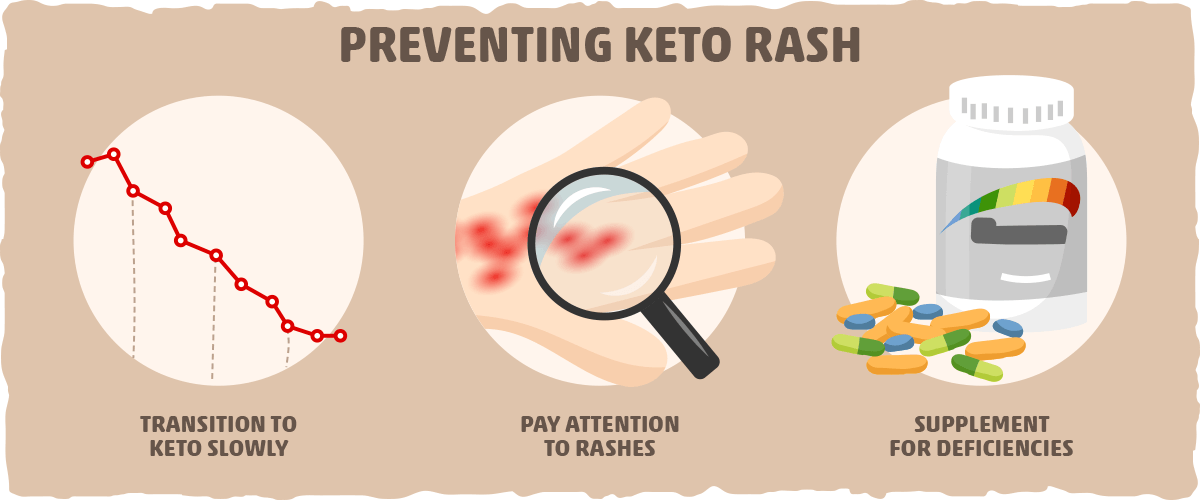
If you haven’t dealt with keto rash before and are just starting keto, you may be wondering how you can prevent this from happening altogether.
Since the exact cause is unknown, there’s no clear rash prevention plan. However, now that we know possible triggers, here are three things you can do:
- Transition to Keto Slowly. Don’t drop your carb consumption drastically or fast for long periods if you’ve never done it before. You will want to lower your carb intake gradually until you can enter and stay in ketosis without any signs of a rash.
- Pay Attention to Minor Rash Symptoms. Increase your carb intake as soon as you see signs of a keto rash to keep it from progressing to more advanced stages. You can also try using other strategies from the list of potential cures above to help it heal.
- Supplement. Immediately start supplementing to avoid deficiencies.
Follow these steps during the first few weeks you start on the keto diet. After you do this, your body will be much more prepared to handle ketone production than before. This means that will have a much lower risk of getting a keto rash.
The good news is that the odds are on your side. It’s unlikely you will get a keto rash in the first place. Even if you do get the keto rash, it will just be an unsightly nuisance that will go away when you use the relevant strategies from this article.
The Worst Case Scenario: What If the Keto Rash Keeps Coming Back?
Even with treatment, the keto rash might not go away completely after several months, or it might go and reappear a few weeks later when you start the keto diet.
If this happens to you, then this means that the triggers that exacerbated your rash aren’t being addressed. The rash will not heal unless the underlying cause(s) are no longer in effect.
Fortunately, if the rash came as a result of following the keto diet, then you will most likely be able to treat it by simply increasing your carb intake until it clears up.
However, this also means that you may not be able to follow the keto diet without getting the rash (if it keeps coming back when you are on keto).
If this is the case for you, then I recommend upping your carb intake until you find the “sweet spot” where you don’t get the keto rash, but you are still getting the results you want.
Although you won’t be getting all of the benefits of the keto diet with this approach, you will be able to improve your health without having to deal with that nasty keto rash.
Putting It All Together — Everything You Need to Know about The Keto Rash
The keto rash is an unfortunate side effect for many keto dieters. Although the exact cause is not yet known, there is reason to believe that ketone production triggers the rash.
More specifically, acetone secretion may be the main culprit. For many first-time keto dieters, their acetone levels may increase so much that they start to sweat out the excess amount of acetone, which irritates the skin and causes the keto rash overtime.
Fortunately, there are a couple of strategies we can use to remedy the rash:
- Let it heal on its own as you adapt to keto
- Increase your carb intake
- Try eliminating allergens from your diet
- Supplement with vitamins, minerals, and omega-3s (if you are deficient in them)
- Eat more anti-inflammatory foods
- Avoid skin irritants
- Don’t allow sweat to sit on your skin
- Use stress-relieving techniques
Although each one addresses different aspects of the keto rash, you may be able to reverse your symptoms by using one or two of the strategies that are most relevant to your situation.
And if all else fails, you can also try talking to your doctor about using antibiotics to treat the rash.
The good news is that keto rash is relatively rare and will almost always go away when you follow the recommendations in this article. The bad news is that – even if you don’t get the keto rash – you may experience other side effects when you start restricting carbs as well.
If you’d like to learn more about the other potential side effects of keto dieting, read through our guide to the keto flu and how to remedy it. Then, once you’ve remedied the rash and overcome the keto flu, you will be on the fast track to reaping the benefits of the keto diet.
Sources
- Prurigo pigmentosa: Report of two cases in the United States and review of the literature — UC Davis
- Prurigo Pigmentosa: A Distinctive Inflammatory Disease of the Skin — Ovid
- Prurigo pigmentosa: a clinicopathologic study of 16 cases — Wiley Online Library
- Is capillary ketone determination useful in clinical practice? In which circumstances? — NCBI
- Prurigo pigmentosa in Korea: clinicopathological study — Wiley Online Library
- Prurigo pigmentosa: Clinicopathological study and analysis of 50 cases in Korea — Wiley Online Library
- Bullous prurigo pigmentosa and diabetes. — NCBI
- Skin Rashes Caused by Vitamin Deficiency — LIVESTRONG
- OSH Answers Fact Sheets — CCOHS
- What Is Acetone and Why Is It Important? — Ruled.me
- The total antioxidant content of more than 3100 foods, beverages, spices, herbs and supplements used worldwide — NCBI
- Anti-inflammatory effects of plant-based foods and of their constituents. — NCBI
- Omega-3 Supplements: In Depth — NIH
- Berries: Anti-inflammatory Effects in Humans — ACS Publications
- Molecular mechanisms of inflammation. Anti-inflammatory benefits of virgin olive oil and the phenolic compound oleocanthal. — NCBI
- Potential Therapeutic Effects of Curcumin, the Anti-inflammatory Agent, Against Neurodegenerative, Cardiovascular, Pulmonary, Metabolic, Autoimmune and Neoplastic Diseases — NCBI
- The Immunomodulation and Anti-Inflammatory Effects of Garlic Organosulfur Compounds in Cancer Chemoprevention — NCBI
- L-Glycine: a novel antiinflammatory, immunomodulatory, and cytoprotective agent. — NCBI
- Stress and the skin. — NCBI
- Cruciferous vegetable intake and mortality in middle-aged adults: A prospective cohort study. — NCBI
